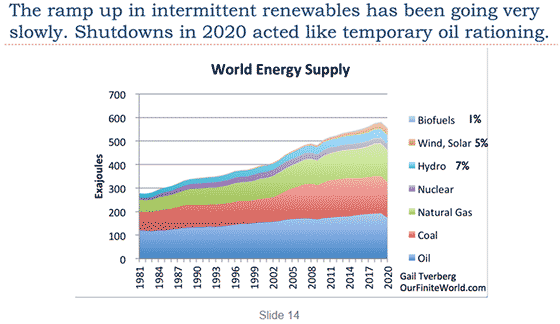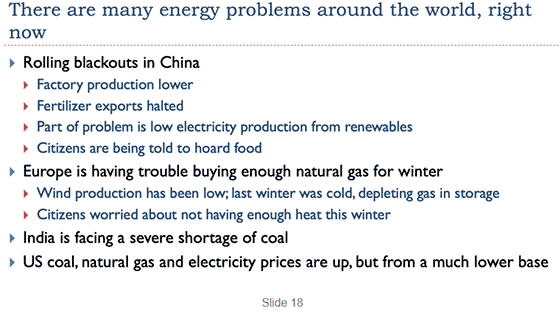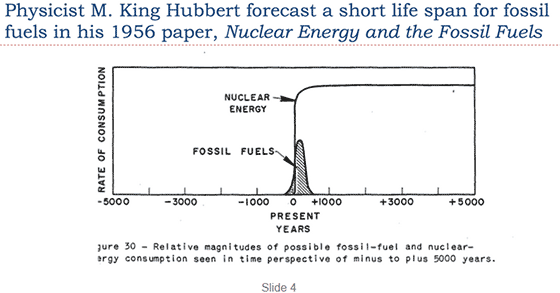Filtering the message on our energy predicament
The Biden regime has deliberately transitioned America from an energy independent country to one that is begging OPEC to sell us more oil, while simultaneously selling our strategic oil reserves to China and India. This must certainly be the epitome of insanity.
Yet the question that needs to be asked is: how much energy is actually available in the long term? Gail Tverberg discusses the question in the following article, and explains why we are avoiding that crucial question.
Our fossil fuel energy predicament, including why the correct story is rarely told, Our Finite World, November 10, 2021:
There is more to the fossil fuel energy predicament than we usually hear about.
Strangely enough, a big part of the confusion regarding the nature of our energy problem comes from the fact that virtually everyone wants to hear good news, even when the news isn’t very good. We end up seeing information in the Mainstream Media mostly from the perspective of what people want to hear, rather than from the perspective of what the story really is. In this post, I explain why this situation tends to occur. I also explain why our current energy situation is starting to look more and more like an energy shortage situation that could lead to economic collapse.
This post is a write-up of a presentation I gave recently. A PDF of my talk can be found at this link. An mp4 video of my talk can be found at this link: Gail Tverberg’s Nov. 9 presentation–Our Fossil Fuel Energy Predicament....
This is a physics issue. Without fossil fuels, we would find it necessary to go back to using older renewables, such as oxen or horses for plowing, burned wood and other biomass for heat, and wind-powered sail boats for international transport.
Needless to say, these older renewables are only available in tiny quantities today, if they are available at all. They wouldn’t provide many jobs other than those depending on manual labor, such as subsistence agriculture. Nuclear and modern renewables would not be available because they depend on fossil fuels for their production, maintenance and long distance transmission lines....
... Slide 14 shows recent energy production. A person can see from this slide that wind and solar aren’t really ramping up very much. A major problem is caused by the fact that wind and solar are given the subsidy of “going first” and prices paid to other electricity producers are adjusted downward, to reflect the fact that their electricity is no longer needed by the grid. This approach tends to drive nuclear out of business because wholesale electricity rates tend to fall to very low levels, or become negative, when unneeded wind and solar are added. Nuclear power plants cannot easily shut down. Instead, the low prices tend to drive the nuclear power plants out of business. This is sad, because electricity from nuclear is far more stable, and thus more helpful to the grid, than electricity from wind or solar....
US papers don’t tell us much about these problems, but they are getting to be very serious problems in other parts of the world. The countries with the biggest problems are the ones trying to import natural gas or coal. If an exporting country finds its own production falling short, it is likely to make certain that its own citizens are adequately supplied first, before providing exports to others. Thus, importing countries may find very high prices, or supplies simply not available....
Tverberg then asks: "Would newspapers tell their readers about the problems that seem to be ahead?" She notes that advertisers would be very unhappy and politicians who want to get re-elected would never mention that limits seem to be close at hand.
She notes that "A much more palatable story is 'We are voluntarily reducing our use of fossil fuels, to prevent climate change'." This story is especially popular in Europe is it appears that the story will be pushed with increasing intensity in America by Green New Deal advocates.
Tverberg observes that "With nearly all readers wanting 'happily ever after' solutions, it becomes impossible to publish the real story."
She then discusses the economy as a dissipative structure (a self-organizing system powered by energy), stating that "economists' view of the economy is an old view that doesn't consider the physics of the system."
In other words, physical limits to energy availability are something that no one wants to talk about.
Tverberg references a graph from M. King Hubbert depicting the short life of fossil fuels compared to the very long life of nuclear energy.
The Green New Deal agenda implicitly recognizes limits to fossil fuel extration. But it is misdirected. The GND is accutely focused on less viable, less reliable, and less durable technologies such as wind and solar power.
Until the GND acolytes actively embrace nuclear energy as a long-term energy source, it seems fairly evident that the GND agenda revolves around controlling and curtailing America's economy and the American standard of living.
Here are a few articles that explore energy limits in more detail.
Blip: Humanity’s 300 Year Self-Terminating Experiment With Industrialism, by Frosty Wooldridge, January 26, 2020.
Oil System Collapsing so Fast It May Derail Renewables - Oil and gas industries are cannibalising themselves as the costs of fossil fuel extraction mount, by Nafeez Ahmed, Byline Times, October 9, 2021.
Degrowth and the Great Reset, by Fred Elbel, October 21, 2021.



